Headaches and Migraines

Do you frequently have headaches or migraines? If a headache is an issue that interferes with your day-to-day life, then read on for more info and help!
In this blog on headaches and migraines, you will learn:
- What is a headache, symptoms & common triggers
- What are the root causes of headache and migraine
- What solutions are available with Functional Medicine to reduce or eliminate headache and migraine pain
WHAT ARE HEADACHES & MIGRAINES?
The topic of headaches and migraines is more complicated than you would think. There are more than 200 types of headaches and 13 types of migraine in medical research (May, 2018).
- Headache disorders are currently the 6th leading cause of disability worldwide (Anheyer D, 2020).
- 90% of people have experienced headaches at least once in their lifetime and 14% of adults have a headache once per week (Turkistani A, 2021).
A headache is pain in the head. It may be on one or both sides of the head. It may be sharp, throbbing or a dull ache. A headache can come on gradually or suddenly. It can last for less than an hour to several days.
A headache is either primary or secondary. With a primary headache, the headache itself is the disease. It is a condition in its own right and not caused by another disease. In a primary headache, brain cells, nerves, blood vessels or muscles around the head send pain signals to the brain.
Types of primary headache include migraine, tension headache, cluster and other primary headache types. A migraine can last from 4 to 72 hours (May, 2018). The pain is stabbing, often with a pulsing feeling. It can come with other symptoms such as nausea and oversensitivity to light and noise.
A secondary headache is due to something else. It may be a brain tumor, cerebral hemorrhage, aneurysm, neurological issue or a serious underlying disease (May, 2018). For example, issues with blood vessels in the brain, including stroke, can cause a secondary headache.
Should you worry about a headache? Secondary headaches are a symptom of another disease and are potentially dangerous. In certain situations, it might be necessary to quickly see a doctor for tests to rule out other causes of the headache like a tumor, abnormal brain structure or stroke (May, 2018).
Secondary headaches may have the following characteristics, in which case it is best to see a doctor (NIH, 2023):
- Sudden, severe headache with fever, nausea, vomiting, a stiff neck, confusion, weakness, double vision, or loss of consciousness
- Two or more headaches a week or a headache that gets worse over days/weeks or changes in pattern
- Headache after a head injury
- Headache with loss of sensation or weakness in any part of the body, which could be a sign of a stroke, with convulsions and/or shortness of breath
- Persistent headache in someone who is usually headache-free, especially over age 50
- New headaches in a person with a history of cancer or HIV/AIDS
WHAT ARE THE KEY CAUSES OF HEADACHES & MIGRAINES?
There are general causes or triggers for headaches. These can vary from person to person but common triggers are (NIH, 2023):
- Loud or sudden noises
- Low blood sugar or skipped meals
- Sudden changes in weather or environment
- Bright or flashing lights
- Strong odors, fumes or cigarette smoke
- Poor sleep, too little sleep, sleep apnea, insomnia or sleep-wake cycle disorders, narcolepsy
- Stress, mental, interpersonal or emotional conflict, which can trigger pain
- Jaw clenching or joint dysfunction in the lower jaw bone
- Straining head and neck muscles (holding your chin down while reading, holding the phone between your shoulder and ear)
- Degenerative arthritis of the neck
- Depression or anxiety
- Hangover
- Some medications
Some foods can trigger a headache or migraine (NIH, 2023):
- Caffeine and caffeine withdrawal
- Chocolate
- Wine / alcohol
- Aged cheeses
- Aspartame
- The additive MSG
- Some fruits and nuts
- Fermented or pickled goods
- Yeast
- Cured or processed meats
What are the Causes of Secondary Headaches?
Secondary headaches can be potentially life-threatening. Causes can be broadly defined as structural, infectious and vascular causes (Filler L, 2019). For example, a severe headache that starts very suddenly can indicate another health problem like a stroke.
- Increased pressure in the brain: A tumor, infection or extensive buildup of cerebrospinal fluid in the brain can all increase pressure in the brain. This can compress nerves and blood vessels and cause a headache (NIH, 2023). For example, a ruptured brain aneurysm can cause a sudden and agonizing headache.
- Infections: Headaches can be due to fever, viral infection like the flu or a bacterial infection. Inflammation from infections can damage nerve cells and cause dull to severe headache pain. This inflammation can cause brain damage or stroke, among other things. Inflammation of the brain may need urgent medical attention (NIH, 2023).
- Long COVID: Headache is a key symptom of long COVID. A long COVID headache can be an occasional or daily headache that starts during an acute infection. It often comes with other long COVID symptoms, like loss of sense of smell. The pathology is not completely understood but persistent immune system activation is thought to be part of the cause (Tana C, 2022).
Head injury: A headache can be due to a concussion or other head injury. A headache may come on immediately or months later, after a head injury (NIH, 2023).
To Read About Blog Topic, Scroll Down
Want To Work With Our Clinic?
Do you have a chronic or mystery illness that no one has been able to help you with? Are you simply wanting to re-connect with a healthier version of yourself? It’s Time To Finally Feel Better!
What are the Causes of Primary Headaches?
Metabolic syndrome: This is a group of metabolic factors that increase risk for cardiovascular disease. These metabolic factors are abdominal obesity, high blood pressure, high blood sugar/ diabetes/ insulin resistance and high triglyceride/ cholesterol levels.
Insulin resistance is when the body does not respond to normal amounts of insulin. So, more insulin is needed to manage intracellular glucose amounts properly.
Metabolic syndrome is significantly associated with chronic migraine (Fortini I, 2022). There is a link between migraine, metabolic syndrome and insulin resistance. During a migraine, blood glucose concentrations increase significantly. Too high insulin, or insulin resistance, is linked to a 5.7x higher risk of migraine (Fortini I, 2022).
Diabetes: While not a standard symptom of diabetes, a headache can be an early sign of hyperglycemia, or high blood sugar, as seen in diabetes. A diabetes related headache is typically due to hormonal imbalances, blood sugar levels and insulin levels. A headache can come on from high blood sugar, but similarly it can be caused by too low blood sugar. This can happen for example by skipping meals and allowing blood sugar to fall too low.
Obesity, headaches and migraine are also linked. In fact, obesity is estimated to increase migraine risk by 40-80%, with the risk increasing as degree of obesity increases (Fortini I, 2022).
High blood pressure: A symptom of high blood pressure can be a headache. There is a link between chronic hypertension and headache, particularly migraine. It is not well understood but high blood pressure can cause headaches because it affects the blood-brain barrier (Arca KN, The Hypertensive Headache: a Review, 2019).
Dehydration: Dehydration can cause or worsen a headache (Arca KN, 2021). Things that contribute to dehydration are sweat, cold, altitude, lack of adequate water intake, low electrolyte levels, certain diuretic medications, diarrhea or vomiting (Arca KN, 2021). Despite the known relationship between dehydration and headache, the mechanism is not fully understood (Arca KN, 2021).
Exposure to a substance or its withdrawal: Headaches can be due to drinking alcohol, carbon monoxide poisoning, exposure to toxic chemicals and metals, cleaning products or solvents, and pesticides. The toxic buildup is usually the cause. In this case, the specific toxins need to be identified and removed. Equally, withdrawal from certain medicines or caffeine after frequent/ excessive use also can cause a headache (NIH, 2023).
Medication: Headaches can result from overuse of a particular medication. These overuse or rebound headaches are actually caused by long-term use of medicines to treat headaches/ migraines. Pain relievers are for occasional pain relief. If taken long term, they themselves can trigger headaches (NIH, 2023). Other medications may cause headache. For example, PPIs or proton pump inhibitors, can cause headache in some people (Cocores AN, 2022).
Gut issues: People with frequent gastrointestinal symptoms have a higher rate of headache (Cocores AN, 2022). For example, nausea, abdominal pain and vomiting are common with a migraine. People with IBS have increased risk of coexisting headache. IBS and migraine might have shared pathological mechanisms (Cocores AN, 2022). In inflammatory bowel disease, the immune response causes increased levels of pro-inflammatory cytokines and these may contribute to headache (Cocores AN, 2022). One small study put 4 people with celiac disease on a gluten-free diet and found that it decreased migraine frequency, duration and intensity (Cocores AN, 2022).
Low iron: With iron deficiency, the brain gets less oxygen which compromises optimal functioning and can lead to headaches (Cocores AN, 2022). Iron deficiency anemia can cause migraines or frequent or recurrent headaches. One study showed that 80% of people with iron deficiency anemia had headaches and 36% had migraines (Cocores AN, 2022). There is a link between iron deficiency anemia, hemoglobin levels and serum ferritin levels and the incidence of migraine in women, but not in men (Cocores AN, 2022). One trial saw significant improvement in headaches after iron supplementation in iron-deficient participants (Cocores AN, 2022).
Hormonal fluctuations: Any fluctuation, increase or decrease, in estrogen levels can trigger headaches and migraines. Migraine is the headache type most affected by estrogen (MA, 2023). Women experience changes in estrogen levels from menstruation, pregnancy, menopause or from exogenous hormones like hormone-based contraceptives, IVF or hormone replacement therapy (HRT). Women may have more headaches around the start of menopause and/or with a hysterectomy. 18-25% of women with migraines have a menstrual link to their headaches (Nappi RE, 2022).
WHAT SOLUTIONS OR TREATMENT ARE AVAILABLE FOR HEADACHES & MIGRAINES?
There are OTC painkillers, like Ibuprofen or other NSAIDs (non-steroidal anti-inflammatory drugs) that can help with the pain. Other types of medications are also an option. However, they can be very damaging to the gut and/or liver over the long term.
We advise looking for and addressing underlying root causes for headaches and migraines. There are also natural methods available for prevention. In fact, research shows that non-pharmacologic therapies can be as effective or better than usual care in reducing headache intensity as well as in improving quality of life (Turkistani A, 2021).
Where to Start?
Start by looking at the basics:
- Address sleep, gut, hormonal issues, dietary deficiencies or triggers.
- Stay well hydrated, avoid chemical exposures and excess alcohol or cigarette addiction.
- Take care of any mental health issues.
- Resolve metabolic syndrome, obesity, high blood pressure, high cholesterol, diabetes/ high blood sugar/ insulin resistance and low blood sugar from inadequate calorie intake.
- Try meditation, breathwork and relaxation training to help with stress levels, pain and the body’s response to stress.
- Review and reassess medications. It might be necessary to stop any medications that trigger headaches.
- Get help to address and fix any postural or arthritis issues.
- Keep a journal of when your headaches or migraines occur. Note down what you were doing, eating, drinking, were you stressed, etc. This can help to identify personal triggers.
At the Medicine with Heart clinic, we can help with all of these concerns or issues. In addition, try some of these known and less well-known approaches to manage and relieve a headache or migraine.
Natural Solutions for Headache & Migraine
Exercise: Aerobic exercise improves migraine symptoms (Barber M, 2020). It reduces migraine frequency, intensity and duration (Barber M, 2020). Higher-intensity training brings on even more benefit. Exercise can help with neck pain or tension headache. People who cannot tolerate high-impact exercise may even benefit from low-impact exercise like yoga.
Possible mechanisms for improving symptoms through exercise include the production of BDNF (brain-derived neurotrophic factor), reduced inflammation and the psychological benefits of exercise (Song TJ, 2021).
Yoga: One study found that yoga improves headache frequency, headache duration and pain intensity of headaches (Anheyer D, 2020).
Magnesium: Low magnesium levels are seen in people with migraines (Shin HJ, 2020). Magnesium is involved in migraine and headaches through neurotransmitter production and other not fully understood mechanisms (Shin HJ, 2020). Supplementing magnesium helps manage migraine headaches and reduces the incidence of migraines significantly (Shin HJ, 2020). Results can be somewhat inconsistent due to differences in magnesium formulation, dose or migraine type.
Magnesium can also help with tension-type headaches (Shin HJ, 2020). Magnesium levels are lower in people with tension-type headaches. Research has found that magnesium improves symptoms of tension-type headaches for at least one year (Shin HJ, 2020).
B Vitamin Complex: B vitamins can help reduce headache and migraine pain. There is a relationship between high homocysteine and migraines (Liampas IN, 2020). The high homocysteine is related to an MTHFR gene variant associated with high homocysteine and migraines (Menon S, 2015). B vitamins help to lower homocysteine and therefore migraines.
Specifically, folate, vitamin B6 and B12 supplementation reduce high homocysteine and migraine symptoms (Menon S, 2015). In research, 3 months supplementation of 400 mg/day of vitamin B2 reduced days, duration, frequency and pain score of migraines (Chen YS, 2022).
Acupuncture: Well-known for its ability to manage pain, acupuncture can help with headaches. Research shows acupuncture can reduce the pain symptoms of headaches and migraines. Acupuncture in migraine is equally as effective or even more effective than preventive medication and has fewer adverse effects (Turkistani A, 2021).
Acupuncture can be more effective than western medicine in treatment of migraine (Li YX, 2020). In one study, acupuncture (12 sessions in 3 months) + routine preventative care led to 22 fewer days of headache, 15% less medication use and 25% fewer visits to the doctor (Turkistani A, 2021).
Physiotherapy: Massage and physiotherapy is another way to reduce pain. One study showed headache intensity was reduced 24% after head and neck massage (Turkistani A, 2021). Spinal connective tissue manipulation and cervical mobilization show significant improvements in headache pain (Turkistani A, 2021). One study showed physiotherapy of massage, relaxation, and stretching (2x week for 4 weeks) significantly reduced reported headache days (Turkistani A, 2021). 54% of participants had a greater than 50% reduction in headache days (Turkistani A, 2021). Physiotherapy, exercise and postural correction significantly decreases the frequency of headache (Turkistani A, 2021).
Botox: Amazingly, Botox can decrease the frequency of migraine attacks per month, pain intensity, medication use, emergency visits and migraine-related disabilities (Shaterian N, 2022). Botox was well tolerated and leads to better quality of life (Shaterian N, 2022). Botox can be used for the treatment of various kinds of migraines, including chronic, episodic, unilateral, and vestibular types. Botox can reduce the frequency of migraine attacks per month and diminish the severity of pain (Shaterian N, 2022).
SUMMARY
- There are more than 200 types of headaches and 13 types of migraine in medical research (May, 2018). 90% of people have experienced headaches at least once in their lifetime and 14% of adults have a headache once per week (Turkistani A, 2021).
- A headache is either primary or secondary. With a primary headache, the headache itself is the disease. A secondary headache is due to something else: a brain tumor, cerebral hemorrhage, aneurysm, neurological issue or a serious underlying disease (May, 2018).
- General causes or triggers for headaches can vary from person to person. Triggers include certain foods, noise, light, poor sleep, stress, postural issues or tight muscles and many others.
- Secondary headaches can be caused by pressure changes in the brain, neuroinflammation, an infection such as long COVID or a head injury.
- Primary headaches can be caused by metabolic syndrome (insulin resistance, high or low blood sugar, diabetes, high blood pressure, obesity, high cholesterol), dehydration, chemical exposures, medications, gut issues, low iron or hormonal fluctuations.
- Solutions to headache and migraine include getting the basics right. This includes sleep, diet, stress management, gut health, blood sugar management, etc. etc.
- Additional ways to manage headaches and migraines include exercise & yoga, magnesium & B complex vitamin supplementation, acupuncture, physiotherapy and Botox.
** Follow us for our next Blog on the Functional Medicine approach to Chronic Disease **
As always, please get in touch with us. If you or someone you know is struggling with headache or migraine pain, contact our clinic today. We can work on any issue(s) and improve your health. Book a free health evaluation call with us today, to see how we can help you with your concerns. We can answer your questions and help you book an initial consult with one of the functional medicine doctors in our clinic.











